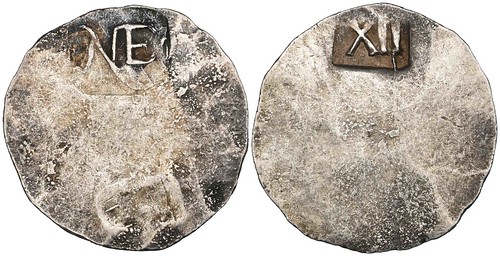
PREV ARTICLE
NEXT ARTICLE
FULL ISSUE
PREV FULL ISSUE
FINEST KNOWN 1652 NEW ENGLAND SHILLINGThe 1652 New England shilling recently discovered in the United Kingdom has been confirmed as the finest-known example of the first coin struck in what is now the US. It is due to be auctioned online on Friday November 26 by Morton & Eden of London. It is estimated to bring £150,000-200,000 (US$200,000-300,000). An ancestor of the current owner was an early settler in New England. Morton & Eden kindly provided this preview draft of the catalogue description. Thank you. Great discovery! -Editor The Property of the Hon. Wentworth Beaumont U.S.A., Colonial North America, New England, shilling, undated, struck in Boston in 1652 by John Hull and Robert Sanderson, the silver planchet countermarked ‘NE' on obverse and ‘XII' on reverse, 72.2 gr. (Noe 3-B; Salmon 3-C), the finest known example of the first coin struck in what is now the U.S.A., recently discovered in the UK and now in NGC holder graded MS61, extremely rare and the only New England shilling to have been classed as ‘Mint State' by either grading service £150,000-200,000
Provenance: This specimen was recently discovered in the United Kingdom in a tin containing numerous coins and medals, many of which are included in this sale (see lots xxx, xxx….) and it has not previously been recorded. Although the possibility exists that the shilling was collected at a later date by one of William Wentworth's numerous descendants (including one Lieutenant Governor and two Colonial Governors of New Hampshire), the presence in the family collection of certain other pieces - notably the Commonwealth unite of 1650 (lot xxx) - is felt to support the hypothesis that William Wentworth probably obtained it when it was new. Hull and Sanderson's New England coins, famously the first pieces to be struck in North America, were produced over a period of just a few weeks in 1652 using puncheons which were, essentially, like hallmarking tools. The present specimen was made when the ‘NE' punch had been re-cut for the third and final time, while the ‘XII' is from the second of four separate reverse punches, this one being distinguished by a pronounced flaw caused by a crack in the punch running from the base of the second ‘I' to its edge. It is believed that this example is the tenth-known coin struck from this combination of punches and its Mint State status is superior to that of all known specimens of the type. As it so happens the next-finest piece is also of the Noe 3-B variety and is graded AU58 NGC (ex Robert Coulton Davis (1890), Thomas Hall, Virgil Brand, Carl Wurtzbach, T. James Clark, F.C.C. Boyd, John J. Ford, Jon Hanson and Donald Partrick).
For more information, see:
To read the earlier E-Sylum article, see:
Wayne Homren, Editor The Numismatic Bibliomania Society is a non-profit organization promoting numismatic literature. See our web site at coinbooks.org. To submit items for publication in The E-Sylum, write to the Editor at this address: whomren@gmail.com To subscribe go to: https://my.binhost.com/lists/listinfo/esylum All Rights Reserved. NBS Home Page Contact the NBS webmaster 
|

